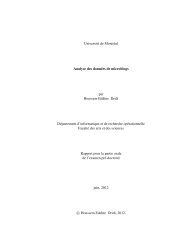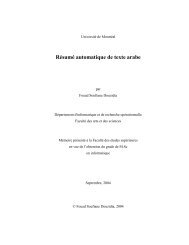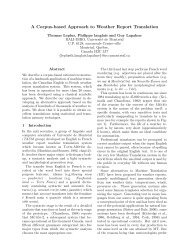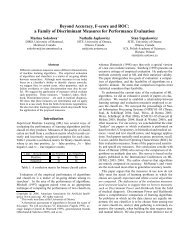Designing a Machine Translation System for Canadian Weather ...
Designing a Machine Translation System for Canadian Weather ...
Designing a Machine Translation System for Canadian Weather ...
You also want an ePaper? Increase the reach of your titles
YUMPU automatically turns print PDFs into web optimized ePapers that Google loves.
<strong>Designing</strong> a <strong>Weather</strong> Warning <strong>Translation</strong> <strong>System</strong> 10<br />
the protocol we used here, so importing their data into our corpus was quite easy.<br />
Moreover, they chose XML as the file <strong>for</strong>mat, which further simplified our task. We<br />
wrote tools to make their tokenization identical to ours, and serialized the corpus.<br />
The content of this corpus exhibits some differences from the corpus of weather<br />
warnings: its sentences are shorter and its vocabulary is simpler. Moreover, the style<br />
is more telegraphic than that of warning discussions. Nonetheless, these <strong>for</strong>ecasts<br />
represent a large amount of material (87k bulletins), due to the high frequency of<br />
their emission, so we felt their use was warranted here as preliminary tests showed<br />
their usefulness.<br />
4.3 <strong>Weather</strong> Warning Text (2000-2011)<br />
<strong>Weather</strong> warning discussions (see Fig. 2) are the main interest of this study. It was<br />
there<strong>for</strong>e important to gather as many of them as possible. Thankfully, we were<br />
able to extract more than a decade’s worth of text from three sources, described<br />
below.<br />
4.3.1 2000-2004: The Work of Langlais et al. (2005)<br />
Once again, we relied on the work of our predecessors on the METEO project, by<br />
reusing the corpus they made available in the course of their study, <strong>for</strong> weather<br />
warnings. As we did <strong>for</strong> <strong>for</strong>ecasts (see Section 4.2), we had to carefully retokenize<br />
the corpus to match our text preparation protocol. We imported some 30k warnings<br />
from this study.<br />
4.3.2 2005-2009: Archives at Environment Canada<br />
In November of 2009, EC sent to RALI an archive of all warnings issued from 2005<br />
to November of 2009. While we were thankful to receive such valuable resources,<br />
folding them into our corpus proved very difficult because of their <strong>for</strong>mat. Indeed,<br />
all warnings issued during every 6-hour time span were concatenated into a single<br />
file, regardless of their language or origin. Since each warning in the archive<br />
used a very loose <strong>for</strong>mat resembling that of an MTCN (see Fig. 2), separating the<br />
warnings from each other required the use of heuristics, patiently developed until<br />
a reasonable result was achieved. Within each isolated warning, we extracted the<br />
text under the ==DISCUSSION== header, if it was present. Otherwise, the warning<br />
text was considered irretrievable automatically and ignored. Had these warnings<br />
been properly <strong>for</strong>matted (say, in XML), these costly manipulations would not have<br />
been necessary.<br />
On top of that, we discovered to our dismay that all occurrences of the string<br />
“FIN” had been replaced by “END”, regardless of the position where it was found,<br />
causing the presence of tokens like “ENDALLY” instead of “FINALLY”, or “BAFEND<br />
BAY” instead of “BAFFIN BAY”. We had to correct this manually by listing and<br />
correcting all the words containing “END” which were unknown to a dictionary.<br />
Finally, matching each warning with its translation proved trickier than we first











